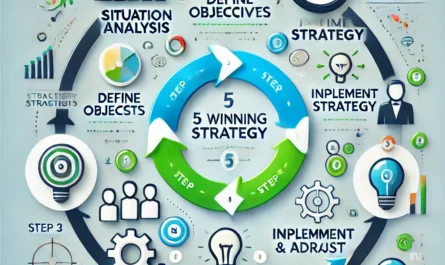In today’s fast-paced business environment, achieving operational efficiency is more than a goal—it’s a necessity. One of the most effective approaches to ensuring this level of performance is through Lean management. Originating from the Toyota Production System, Lean management is a strategy focused on maximizing value while minimizing waste. It’s not just about working harder but about working smarter by streamlining processes, improving productivity, and fostering a culture of continuous improvement. Understanding how to implement Lean management for operational efficiency can transform businesses by promoting agility, reducing costs, and enhancing customer satisfaction.
Lean Management for Operational Efficiency
Lean management is a philosophy built around the idea of eliminating waste in all forms, optimizing processes, and creating more value for customers. Its focus on operational efficiency makes it highly relevant for businesses that aim to stay competitive. By adopting Lean principles, organizations can streamline their operations, minimize downtime, and respond faster to market changes. The ultimate goal is to increase efficiency without compromising quality.
The beauty of Lean management is that it can be applied across various industries, from manufacturing to healthcare to IT services. Regardless of the sector, Lean’s core objective remains the same: to deliver better results with fewer resources. When properly implemented, Lean management can turn a reactive organization into a proactive one, continuously finding ways to improve and adapt.
Understanding the Fundamentals of Lean
To effectively implement Lean management, it’s crucial to understand its foundational principles. Lean is centered on five core ideas:
- Value – Identify what is valuable to the customer and focus all efforts on enhancing it.
- Value Stream – Map out the entire process that delivers this value, from raw materials to the finished product or service, and identify any waste within the stream.
- Flow – Ensure that processes flow smoothly without interruptions or delays.
- Pull – Produce only what is needed based on customer demand, avoiding overproduction.
- Continuous Improvement – Cultivate a culture of ongoing refinement and enhancement.
Each of these principles contributes to creating a Lean system that drives operational efficiency. For instance, by understanding and mapping value streams, businesses can clearly see where inefficiencies lie and take action to correct them.
The Importance of Waste Reduction
At the heart of Lean management is the concept of waste reduction. Waste in Lean terms refers to any activity or process that does not add value to the customer. These can be overproduction, waiting times, unnecessary transport, excess inventory, defects, and more. By systematically identifying and eliminating waste, organizations can significantly boost their efficiency. Moreover, waste reduction leads to cost savings, improved quality, and quicker response times, all of which contribute to better operational performance.
Reducing waste is not just about cutting costs; it’s about enhancing the entire operational ecosystem. For example, eliminating unnecessary steps in production can lead to faster delivery times, which improves customer satisfaction. Similarly, reducing waste in inventory management can free up capital, allowing businesses to invest in other areas of growth.
Identifying and Eliminating Waste
Recognizing waste requires a deep understanding of both the process and the desired outcome. Lean identifies seven primary types of waste, often referred to as “TIMWOOD” (Transportation, Inventory, Motion, Waiting, Overproduction, Overprocessing, Defects). These categories help organizations pinpoint inefficiencies within their operations.
For instance, in a manufacturing setting, unnecessary movement of products between workstations is a form of waste. In a service industry, excessive paperwork or redundant processes can bog down efficiency. By thoroughly analyzing workflows and processes, businesses can uncover wasteful practices and implement Lean solutions to eliminate them.
Lean Tools and Techniques
Several tools and techniques are integral to Lean management and are essential for improving operational efficiency. Some of the most widely used Lean tools include:
- 5S: A methodology for organizing workspaces to improve efficiency.
- Kaizen: The philosophy of continuous improvement involving everyone in the organization.
- Kanban: A system for managing workflow and ensuring tasks are completed in a timely manner.
These tools not only help identify inefficiencies but also provide practical ways to solve them. For example, the 5S methodology helps in creating a clean, organized workspace, reducing the time spent searching for tools and materials.
Creating Value Streams
Mapping out value streams is a critical step in Lean management. A value stream is the complete set of activities required to bring a product or service from conception to delivery. By creating value stream maps, businesses can visualize their entire production process and identify areas of waste.
For example, if there is a bottleneck at a particular stage in the production process, this will show up clearly in a value stream map. This allows teams to focus their efforts on eliminating the bottleneck, leading to smoother operations and faster lead times. Value stream mapping also helps in eliminating non-value-adding activities, which are often hidden within complex processes.
The Role of Leadership in Lean Implementation
Effective leadership is key to the successful implementation of Lean management. Leaders must not only support Lean initiatives but also drive them by setting the right priorities and fostering a culture of continuous improvement. This means providing the necessary resources, training, and support for Lean projects.
A strong leadership commitment is also necessary for sustaining Lean efforts over the long term. Without leadership buy-in, Lean initiatives may falter, especially when challenges arise. Leaders play a critical role in overcoming resistance to change and ensuring that Lean principles become an integral part of the organization’s culture.
You can also read; How to Develop a Strategic Plan for Expanding into New Markets
Employee Engagement in Lean
Engaging employees in Lean initiatives is vital for success. Since employees are often closest to the work, they are in the best position to identify inefficiencies and suggest improvements. Encouraging their participation fosters a sense of ownership and accountability for Lean processes.
Organizations that empower their employees to take part in Lean projects often see higher levels of innovation and creativity. For instance, workers on the production floor may suggest practical changes that managers might overlook, such as repositioning machinery to reduce unnecessary movement. By involving employees in decision-making, businesses not only improve efficiency but also increase job satisfaction and morale.



